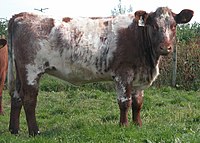Shorthorn: Difference between revisions
m Reverted edits by 216.147.235.164 (talk) to last version by Roberpl |
No edit summary |
||
| Line 1: | Line 1: | ||
'''Amber and james forever!!!!!!!!!!!!!!!!!''' jpg|right|thumb|200px|Shorthorn heifers]] |
|||
[[Image:Red Shorthorn Bull IMG 0077.jpg|right|thumb|200px|A red Shorthorn bull]] |
[[Image:Red Shorthorn Bull IMG 0077.jpg|right|thumb|200px|A red Shorthorn bull]] |
||
[[Image:Light Roan Shorthorn Heifer DSCN1872b.jpg|right|thumb|200px|A roan Shorthorn heifer]] |
[[Image:Light Roan Shorthorn Heifer DSCN1872b.jpg|right|thumb|200px|A roan Shorthorn heifer]] |
||
Revision as of 17:50, 29 January 2009
Amber and james forever!!!!!!!!!!!!!!!!! jpg|right|thumb|200px|Shorthorn heifers]]


The Shorthorn breed of cattle originated in the North East of England in the late 18th century. The breed was developed as dual purpose, suitable for both dairy and beef production; however there were always certain blood lines within the breed which emphasised one quality or the other. Over time these different lines diverged and by the second half of the 20th century two separate breeds had developed - the Beef Shorthorn, and the Dairy Shorthorn. All Shorthorn cattle are coloured red, white or roan, although roan cattle are preferred by some, and completely white animals are not common. However, one type of Shorthorn has been bred to be consistently white – the Whitebred Shorthorn, which was developed to cross with black Galloway cattle to produce a popular blue roan crossbreed, the Blue Grey.
History
The breed developed from Teeswater and Durham cattle found originally in the North East of England. In the late 18th century the Colling brothers, Charles and Robert, started to improve the Durham cattle using the selective breeding techniques that Robert Bakewell had used successfully on Longhorn cattle. The culmination of this breeding program was the birth of the bull Comet, bred by Charles Colling, in 1804. This bull was subsequently sold for 1000 guineas in 1810 at the Ketton sale; the first 1000 guinea bull ever recorded.
At the same time Thomas Bates of Kirklevington and John Booth of Killesby were developing the Teeswater cattle. The Bates cattle were subsequently developed for their milking qualities, whereas the Booth cattle were developed for their beef qualities.
In 1822 George Coates published the first volume of his herd book, this was the first pedigree herd book for cattle in the world.[1]
Coates published the first four volumes, after which Henry Stafford took over the ownership and publishing of the herd book, retaining the name "Coates's Herd Book". The Shorthorn Society of Great Britain and Ireland was founded in 1874, and purchased the copyright of the Herd Book from Stafford. They have continued to compile and publish Coates's Herd Book ever since. The American Shorthorn Herd Book was the first to be published in this country for any breed and was started in 1846, with the formation of the American Shorthorn Association following 26 years later in 1872.[1] Note that in 1958 the Beef Shorthorn breeders of Great Britain and Ireland started their own section of the herd book.
Health
Some Shorthorns have been found to have a genetic defect called Tibial Hemimelia (TH), a disease caused by an abnormal gene. TH was identified in a small number of Shorthorn cattle in Canada in 1999. It is characterized by severe deformities in newborn calves, which are born with twisted rear legs with missing tibias (shin bones) and fused joints, large abdominal hernias and often skull deformities. They cannot stand to suckle and must be destroyed. All the affected animals descend from a single individual. The gene involved is recessive: the disease occurs only when homozygous (two copies of the gene are present); heterozygous (carrier) animals show no symptoms, but are likely to be much more widespread in the population than affected animals.[2]
Distribution
Today the breed is found mainly in English speaking countries, and South America. The main countries are: Argentina, Australia, Canada, New Zealand, Republic of Ireland, South Africa, United Kingdom, United States of America, Uruguay, and Zimbabwe. Beamish Museum in north-eastern England preserves the Durham breed.
Australia
Shorthorn cattle were one of the first purebred breeds to be imported into Australia when several cows were brought into New South Wales in 1800. More purebred Shorthorns were imported into NSW in 1825 by Potter McQueen of Scone.[1] Eight months later the Australian Agricultural Company imported additional Shorthorns.
The breed has a wide genetic base, resulting in the development of several distinct though closely related strains — these are the traditional strains:
- Beef Shorthorn
- Poll Shorthorn
- Durham
- Dairy Shorthorn
- Australian Shorthorn
The current Shorthorn Society of Australia encompasses the Poll Shorthorn, Australian Shorthorn and the Durham.
Many other beef cattle breeds have used Shorthorn genetics in the development of new breeds such as the Belmont Red.[1]
References
- ^ a b c d Beef Breeders' Annual, An Inverell Times supplement, Shorthorn breed arrived with the First Fleet, July 2008 Cite error: The named reference "Times" was defined multiple times with different content (see the help page).
- ^ Tibial Hemimelia, Meningocele, and Abdominal Hernia in Shorthorn Cattle, J. M. Lapointe, S. Lachance and D. J. Steffen, Veterinary Pathology 37: 508 – 511, 2000 Retrieved on 10 November 2008
See also
- Beef Shorthorn
- Dairy Shorthorn (known as Milking Shorthorn in North America and New Zealand)
- Durham Ox
- Whitebred Shorthorn
Breed Associations
- American Shorthorn Association
- Asociacion Argentina de Criadores de Shorthorn
- Shorthorn Association of Australia
- Canadian Shorthorn Association
- Irish Shorthorn Society
- New Zealand Shorthorn Association
External links
- The Shorthorn Breed of Cattle - Oklahoma State University
- Shorthorn Breed Information - Cattle.com
- Chapelton Beef Shorthorns - Pedigree Beef Sires
